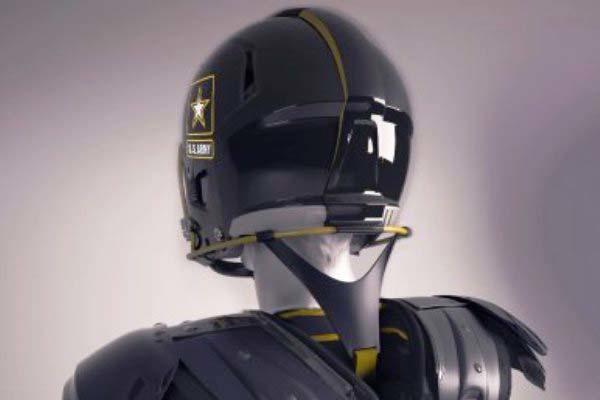Army scientists, working with officials from the National Football League, have developed a wearable device that helps reduce head and neck injuries.
The Rate-Activated Tether, is a flexible strap that connects a helmet to shoulder pads or body armor, said Shawn Walsh of the Weapons and Material Research Directorate at Army Research Laboratory.
"What happens is if that when head is exposed to adverse acceleration, this RAT strap will basically transition into a rigid device that will transmit the load to the body, and it has been proven to significantly reduce acceleration," Walsh told defense reporters at a recent roundtable discussion sponsored by Program Executive Office Soldier.
Over the years, the Defense Department has partnered with the NFL and the National Collegiate Athletic Association to research brain injuries. For example, the Army beginning in 2007 put blast sensors into tens of thousands of helmets to monitor head injuries from roadside bombs in Afghanistan. And the Pentagon and NCAA in 2014 announced a joint study into concussions.
Army scientists are not sure if the device will eliminate Traumatic Brain Injury or concussions, but "we can say with some confidence that there is some benefit to reducing adverse acceleration," Walsh said.
The device could help to prevent head injuries sometimes experienced by paratroopers, Walsh said.
"It is a known fact that paratroopers do experience head injuries," he said. "They are trained to land very carefully, but sometimes at night, in the rain or in irregular terrain and something goes just a little off, they can land on their head," he said. "There is some very real Army applications associated with that as well."
Army officials also discussed more long-term science and technology initiatives such as a project to design robots that could one day deploy shields to protect soldiers in a firefight.
"Part of our job at the research center is to kind of try to push the Army out of its comfort zone," Walsh said. "One of the things we are exploring now is robotics."
An effort known as Robotic Augmented Soldier Protection is designed to shadow soldiers and deploy a protective shield when an attack occurs, Walsh said.
"A lot of people associate robotics with lethality, but what we are looking at is can we use robotics in a purely protective mode?" Walsh said. "Can we use these robotics to deploy protective mechanisms … that can work to protect a human?"
What is lacking right now is the science, Walsh said, adding that the Army is trying to work with the academic community on the effort.
Army officials that develop soldier requirements at the Army's Maneuver Center of Excellence at Fort Benning, Georgia are also interested in the concept, said Col. Curt "Travis" Thompson, director of the Soldier Division at Training and Doctrine Command's Capability Manpower – Soldier.
"We are the closest touchpoint to the soldiers who are out in the field … but that doesn't mean that we are the closest touch point to the realm of the possible or where we should be going," he said. "We absolutely rely on ARL to kind of inform us to what is possible."
The service's leadership has shown interest in the effort, Walsh said.
"The Army is encouraging us; we were actually down at Fort Benning," Walsh said. "They want to see more prototyping. They want to be introduced to these concepts as soon as possible."
While still a fledgling effort, ARL does have a working prototype, he said.
"We are not saying that every soldier would have one," Walsh said. "This is only useful in certain scenarios."
-- Matthew Cox can be reached at matthew.cox@military.com.



























